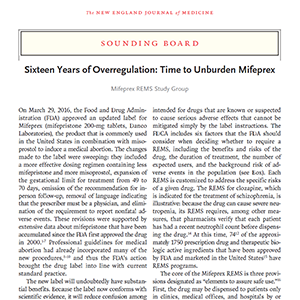 REMS place medically unnecessary burdens on patients and providers, and keep mifepristone from being prescribed by clinicians or sold in pharmacies alongside hundreds of other prescription medications. Overregulation means that fewer providers offer mifepristone and fewer women have access to this safe and effective option for ending a pregnancy. This burden is especially heavy on poor and rural women.
REMS place medically unnecessary burdens on patients and providers, and keep mifepristone from being prescribed by clinicians or sold in pharmacies alongside hundreds of other prescription medications. Overregulation means that fewer providers offer mifepristone and fewer women have access to this safe and effective option for ending a pregnancy. This burden is especially heavy on poor and rural women.
In “Sixteen Years of Overregulation: Time to Unburden Mifeprex,” researchers criticize the FDA regulation mechanism known as a “REMS” (Risk Evaluation and Mitigation Strategy). The REMS restrictions, implemented when mifepristone was first introduced in the U.S. in 2000, currently have stipulations that are unlike what is required to provide most medication:
- Mifepristone can only be dispensed to patients in clinics, medical offices, and hospitals by or under the supervision of a certified prescriber; it may not be prescribed by clinicians or sold in retail or mail-order pharmacies;
- All providers who offer mifepristone must complete an unnecessary certification process, attesting to skills that are common to all women’s health providers; and
- Each woman taking mifepristone must receive a Medication Guide and sign an FDA-approved Patient Agreement—an unnecessary requirement since providers already give women the information they need.
For more information, read the full commentary on the New England Journal of Medicine website.
Also, read Dan Grossman’s op-ed in the LA Times about how improving access to medication abortion could better meet women’s desires for timely abortion care.
